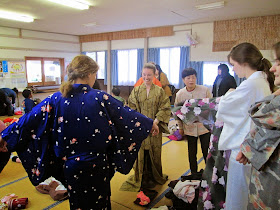This week was my first full schedule
with the new first years, and I’ve enjoyed it immensely. With the end of our
contracts a little over 3 months away, everyone is posting about whether their
decision to leave or stay was the right one, and I totally understand that.
Starting afresh with a new group of
students, knowing what I’m doing, and having experience behind me, the
difference between these self introdctions and my ones in August is marked.
Recently, waking up in the morning, the way I feel before teaching has tipped
to the excitement outweighing the nervousness. It’s not even that the content
of my lessons has changed that much, more that I can now feel at ease in front
of a 40-strong class; not feel compelled to fill an unsure silence; exert a
little more authority and know more instinctively what will and won’t work off
the paper lesson plan. Because of the difference in the academic calenders
between Japan and English-speaking countries, it makes sense for us to arrive
here one semester into the school year. But I’m only realising now why they say
two years gives you the best experience, and it’s undeniably better for the kids.
 |
| Crazy good drawing a student just casually did one night for their school-trip book cover |
In terms of being in Japan, staying
for a year makes sense for me and I’ll have accomplished my original goals.
I’ve traveled all over the country; gained a measure of understanding of
Japanese society and culture; tried teaching; kept up writing; got experience
with public speaking and leading that I never had at university; become more
self-sufficient; learned how to communicate with just about anyone regardless
of age, background or language; lived as a minority; and become totally
financially independent straight after graduating.
Nevertheless, I think two years is
optimal for real job satisfaction.
If the JET Programme and the Japanese
Ministry of Eduction is serious about improving English teaching in schools,
they need to focus on quality and not quantity of ALTs (which seems to be the
plan.) In real terms, I think that might mean a 2 year minimum contract, and
more training both for us and the JTE’s who will team teach with us. And
although the Programme seems pretty good at finding the right placements for
participants, they also need to do a lot of streamlining. I’ve heard so many
stories of JETs being paid to sit at their desks for weeks on end – making
bulletin boards, writing newsletters, studying Japanese and eventually knitting
and watching movies. Great for those who want a gap year lifestyle while
pursuing their own projects – not so great for those who actually want to
teach, or for the state of English learning in Japan.
The Programme has changed a lot since
its early days in the 80s, when it was just a handful of top graduates given 4+
weeks of training. It’s hard to say how long it will survive as it is, and it’s
most definitely not perfect. Nevertheless, I still think ALTs have a huge part
to play here, in pushing students to communicate in real English rather than
memorised chunks of grammar, and in providing rare and real foreign
interaction.
Yesterday I went on a school trip
with the new first years to the famous Saito Burial Mounds. We climbed hills to
view the vistas, wandered through a cherry orchard, and played dodgeball among
the barrows. My students were relaxed, witty, unbelievably energetic. It was a
perfect spring day, the likes of which I’ve only really read about. A cool wind
ran over the sun-warmed meadows and the rice paddies were punctuated by tiny
white trucks and old women in bonnets. The air literally smelled sweet. I’m
going to miss this country so much.




















































